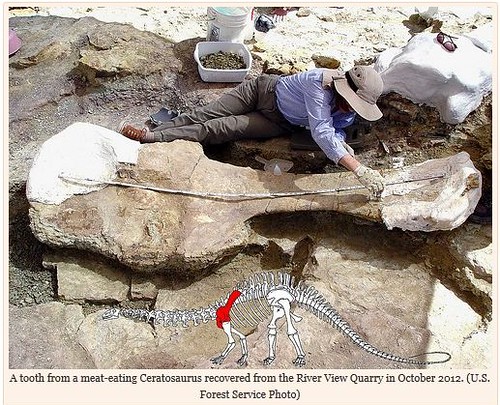
The discovery is not surprising. Dinosaur bones are so common there that dinosaurs are the third topic in the "Frequently Asked Questions" which notes, "The Comanche National Grassland has the longest set of dinosaur tracks in North America." The banks of the Purgatoire River has more than "1300 prints in 100 separate trackways." Due to the many dinosaur fossils found in the Comanche National Grassland, the United States Department of Agriculture notes, it's being called the "tossed salad of dinosaur parts."
The popular interest in dinosaurs is strong enough to support not only the Jurassic Park film franchise, and Jim Henson's Dinosaur Train but also assorted rip-offs and homages. Bob Strauss (About.com) tries to explain children's fascination with dinosaurs:
The most likely explanation for why kids love dinosaurs is that these huge, dangerous reptiles went extinct over 65 million years ago (though that might as well be 65 years from the perspective of your average pre-schooler). The fact is, most kids don't worship at the altar of lions, tigers or timber wolves, probably because these fierce carnivores can easily be seen (either at the zoo or on TV) stalking their prey and ripping into freshly killed antelopes. Children have vivid imaginations, meaning it's a short step from witnessing a hyena demolishing a wildebeest to picturing themselves on the lunch menu.
So kids "love dinosaurs" because they've been extinct for millions of years? Really? Because Strauss starts his info-tour by explaining that a child "as young as two or three" can sometimes pronounce "tyrannosaurus' before he can wrap his mouth around 'please' or 'thank you'." And a two or a three-year-old is not someone who can understand 'extinct' -- a million years ago or 60 seconds ago. Whatever the reason for the fascination, it's more complicated than 'because the dinosaur is extinct.'
And dinosaurs weren't even the first extinct beings the public grew fascinated with. Keith Thomson (American Scientist) observed:
They were not the first prehistoric creatures to gain wide attention. In 1801 Charles Willson Peale, a talented artist, showman, and inventor of the modern natural history museum, excavated the remains of three large mastodons from Newburgh, New York. The display of one of Peale's mastodons in Philadelphia helped start the public fascination with fossils.
The US Forest Service notes many discoveries have been made at Comanche National Grassland, "Recent work at the river view quarry has produced numerous dinosaur bones including shed teeth of carnivorous dinosaurs. Like sharks, dinosaurs continually shed teeth, which explain why the river view deposit is full of scattered and incomplete bones, some bearing actual bite marks."